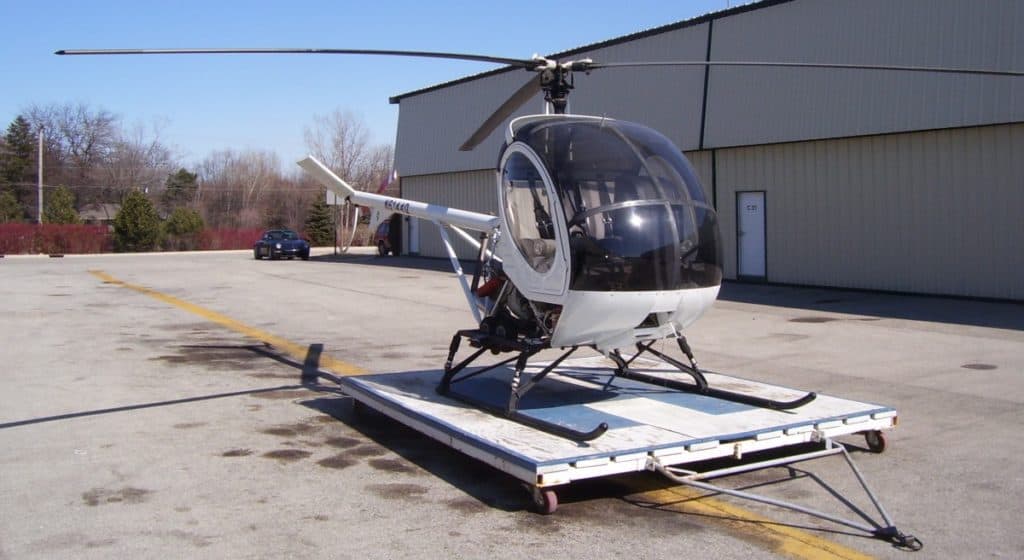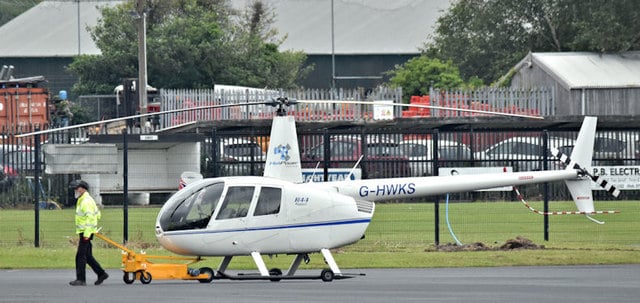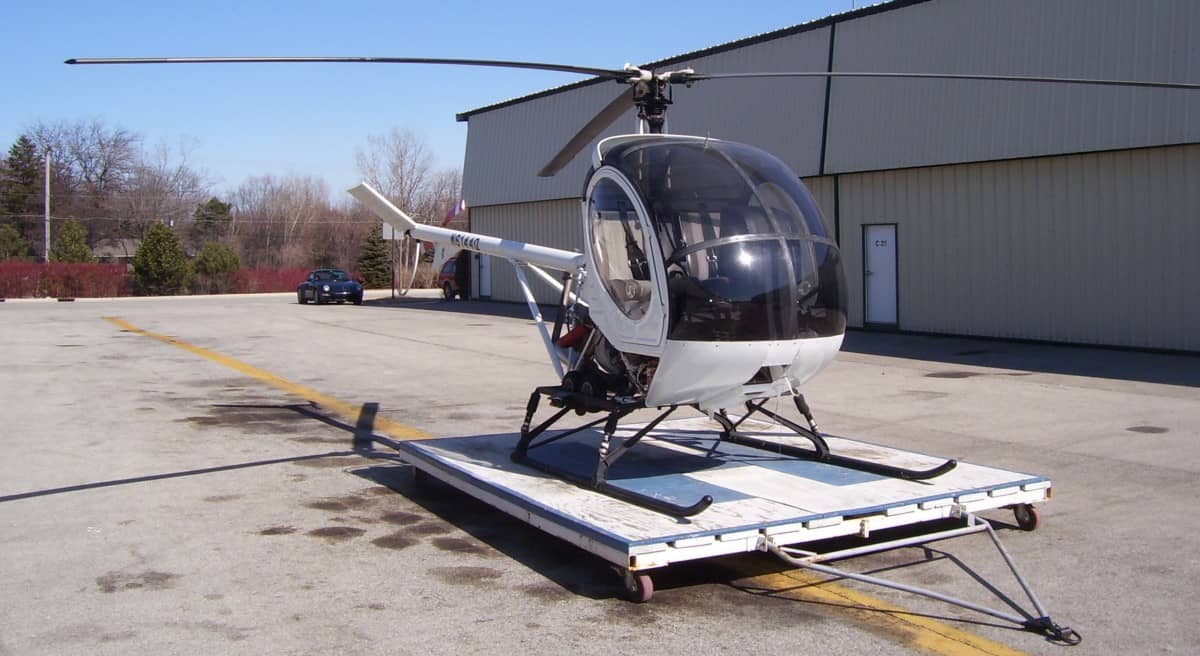
You may have seen helicopters sitting out on the apron or helipad and thought nothing of it, but then when you see a helicopter sitting in a hanger the thought may have come up as to how they get the helicopter from the hanger to outside so it can take off? Depending on the type of helicopter, moving it around on the ground can be fairly simple or take a little bit more work.
Helicopters without wheels can only move on the ground by use of a dolly, tow-cart, or ground-handling wheels. Helicopters with wheels can be towed using a tow vehicle and towbar and can move by using the thrust produced by its main rotor when running. Helicopters without wheels need to hover taxi.
Having flown both types of helicopters – ones with wheels and ones without I can give you some insider knowledge on how helicopters move around when on the ground. Helicopters that don’t have wheels have landing gear known as ‘Skids’. The helicopters with skids provide the most problems to personnel trying to move them around while they are on the ground.
How Do You Move a Helicopter Out of a Hanger?
For helicopters that have wheels, moving a helicopter in and out of the hanger or around the apron is a simple task. You connect a tractor, tug, or tow vehicle to the aircraft using a tow bar, release its brakes and pull/push it wherever you wish. Pretty simple.
For helicopters with skids, there are three main ways to move a helicopter:
- Tow-Cart
- Dolly
- Ground Handling Wheels
Moving a Helicopter Using a Tow-Cart
Tow-Carts are an electric/hydraulic device that attaches to the helicopter skids, picks it up, and allows the helicopter to be driven around. These are great devices that allow even large helicopters to be moved just by a single person. They come in a range of sizes to suit all helicopters.
Moving a Helicopter Using a Dolly
A helicopter dolly is a large platform mounted on wheels. The helicopter pilot lands the helicopter on the dolly and then it can be moved around using a tow vehicle, or some really fancy dollies are on rails that can move the entire machine in and out of a hanger with just the press of a button!

Dollies are a great way to allow a helicopter to be moved by just a single person but if they are small they can be dangerous to land on for a novice pilot, especially in high winds. Catching a skid on the edge of the dolly leads to Dynamic Rollover with catastrophic results!
In this case, the helicopter was doing maintenance runs, and the dolly was not chocked to prevent it from rolling. It starts to roll and the pilot panics and pulls the helicopter into the air but not high enough. They catch a skid and that’s the beginning of the end for that helicopter! The report from the police department says it was caused by a sudden gust of wind, but in my opinion, that sounds like BS. Someone screwed up by not choking the dolly!
Moving a Helicopter Using Ground Handling Wheels
Every helicopter comes from the factory with a set of ground-handling wheels. These are wheels that temporarily attach to the skids and then use either a hydraulic mechanism to lift each skid up off the ground or in smaller helicopters, a cam mechanism.

Small helicopters like a Robinson R22 or Gumibal Cabri can easily be moved by a single person but once you get into helicopters larger than two seats you either need some kind of tow device or multiple people to help move the helicopter because of its weight.
How Do Helicopters Taxi?
Now that we have seen how a helicopter is pushed/pulled or towed around the hanger how do helicopters get from the hanger to the takeoff and landing locations? At some airports, there are designated areas that helicopters can only operate from or they may be restricted to landing and taking off only from a runway, so how do they get to those locations?

Join My Newsletter & Get Great Tips, Information and Experiences To Help You Become a Superb Pilot!
How Do Helicopters Ground Taxi?
Ground taxiing is used for helicopters with wheels only. When the pilot pushes slightly forward on the cyclic it tilts the rotor disk forward and creates a thrust vector towards the rear of the helicopter, just like they were accelerating away while in flight. The rearward thrust moves the helicopter forward.
Once the pilot releases the brakes the helicopter will begin to roll forward, this is known as ground taxiing. To turn the helicopter the pilot pushes on the foot pedals to make the tail rotor push the rear of the helicopter left or right, thus swinging the nose in the opposite direction:
Ground taxing works great to help keep debris and rotor wash to a minimum. It requires far less blade pitch to ground taxi, thus the amount of rotor wash produced is far less than if the helicopter was hovering. This is great for taxiing around airports with private and corporate jets parked close by and not peppering them with dust and debris!
How Do Helicopters Hover Taxi?
Hover taxiing is primarily used by helicopters that only have skids, although wheeled helicopters can hover taxi too, especially if they are trying to move around a grassed field etc. Hover taxiing is just what it sounds like, it is when the helicopter is in a hover and moves from point A to point B. Most helicopters hover around 5 – 10 feet depending on their size.
This is how I move my Astar around when I need to taxi from my parking spot to the takeoff point. A hover taxi is done at a typical hover height and at a slow speed and is used to cover only small distances, but it does create a lot of rotor wash and dust when lifting off next to the hanger and other aircraft. With skidded helicopters, there is no other option.
How Do Helicopters Air Taxi?
If the helicopter has to cover a large amount of ground to get to its takeoff point or from its landing point then a maneuver called an Air Taxi is used. For instance, if air traffic control wants them to take off from a runway, the pilot needs to taxi down the taxiway but at an acceptable pace, or if the pilot wishes to get to the airport’s infield for training.
An air taxi is usually completed under 100ft above the ground and up to 40kts. As the pilot approaches the area they wish to land at they will slow down to a hover taxi and then land or hover in that location before departing.
To Finish
Helicopters are moved on the ground using tow vehicles, ground handling wheels, dollies, or their own power. Wheels make it much easier if they are already attached to the helicopter but these add weight and complexity to the helicopter which is not justifiable on the smaller, cheaper machines.
To move around from point A to B helicopters either have to ground taxi or hover taxi. Both have their own benefits but it all depends on the type of helicopter the pilot is flying and the surface on which the helicopter is moving on.
Further Reading
If you found this article helpful may I suggest these other articles too:


